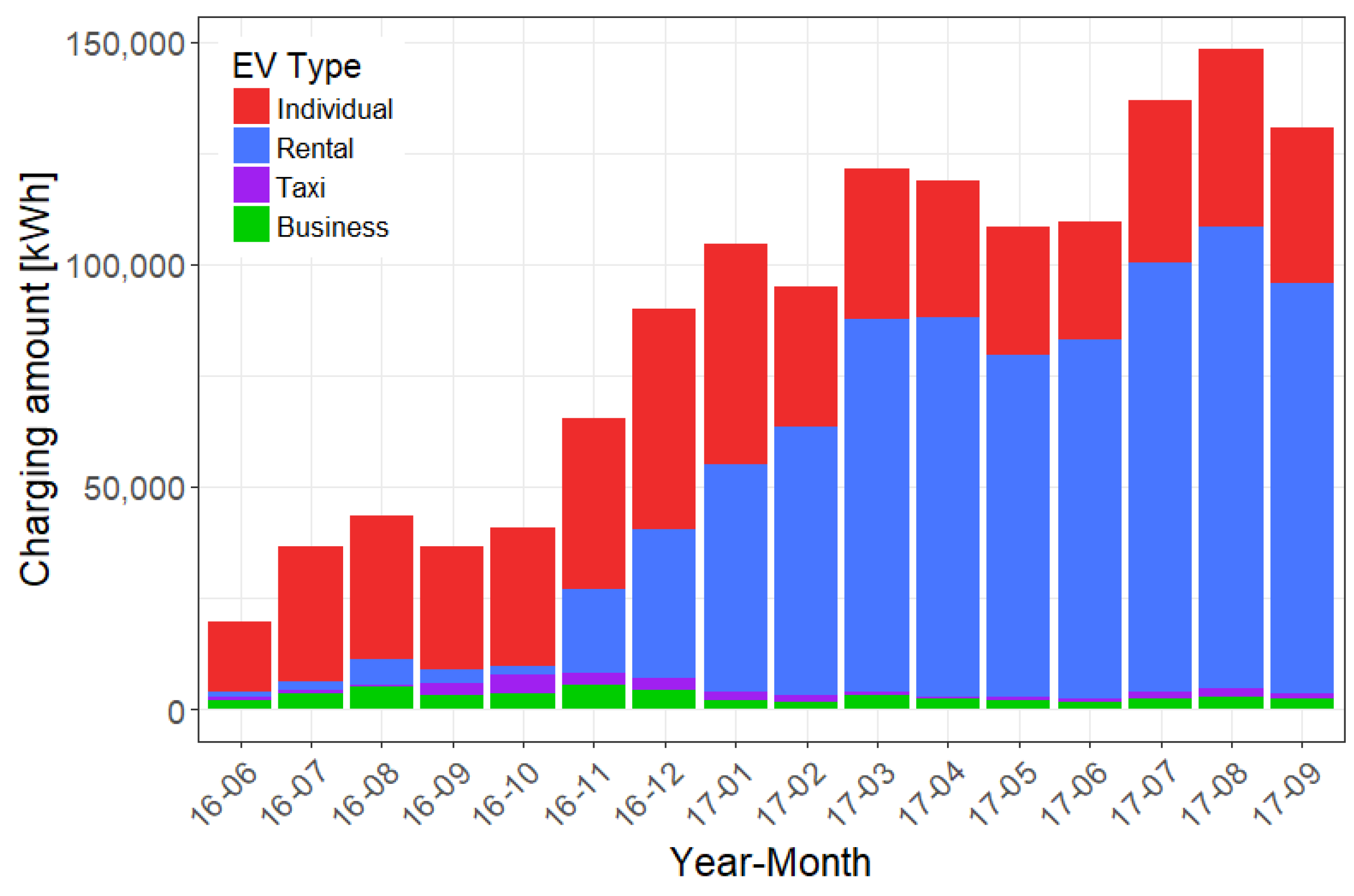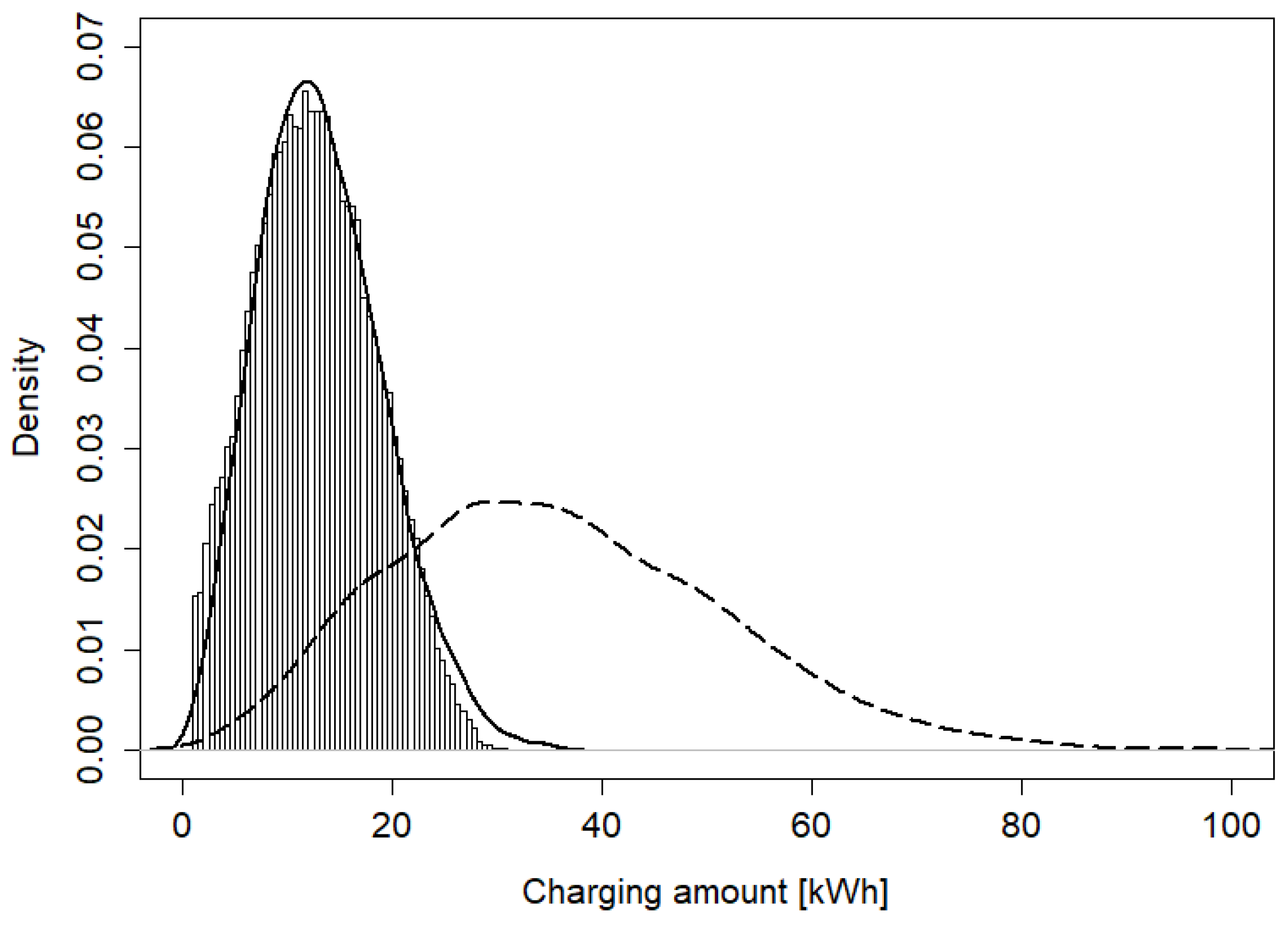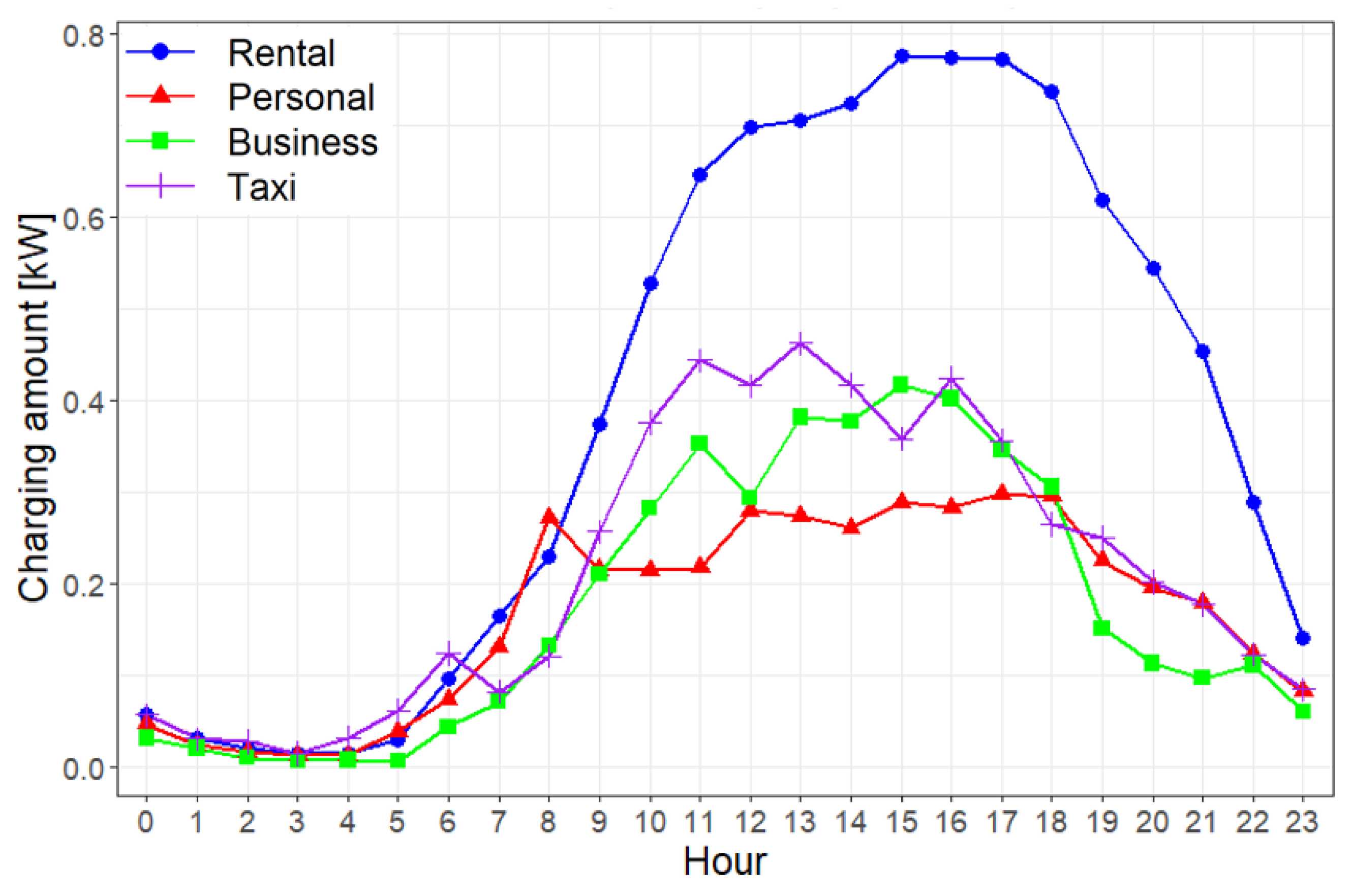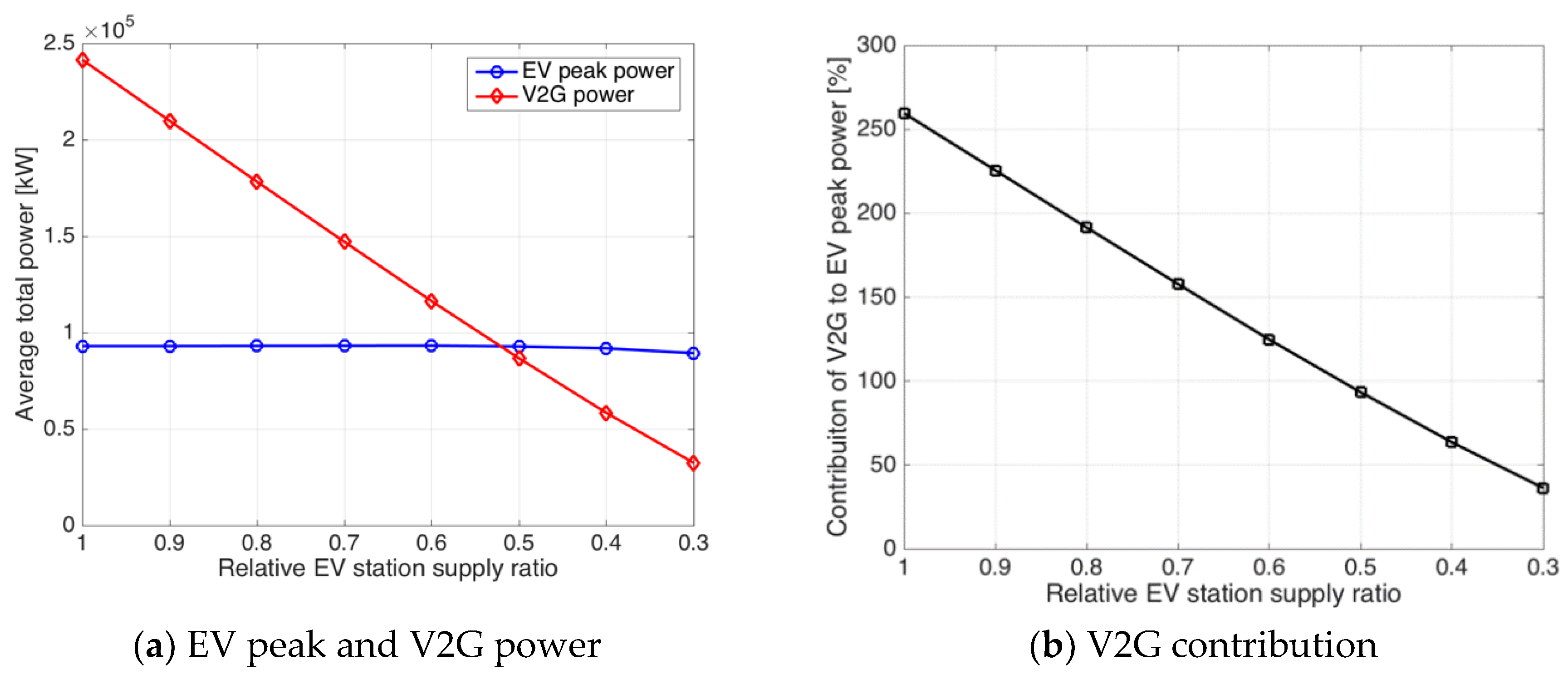Study on EV Charging Peak Reduction with V2G Utilizing Idle Charging Stations: The Jeju Island Case
Abstract
:1. Introduction
2. Outline of the Jeju Island Power System and EV Transition Plan
2.1. Status of Jeju Island’s EV Transition Plan and Demand Forecast
2.2. Analysis of EV Charging Pattern
2.2.1. EV Charging Amount per Visit
2.2.2. Analysis of EV Charging Pattern
2.3. EV Charging Demand Forecast
2.4. EV Charging Station Installation
3. EV Station Operation to Reduce EV Charging Peak
3.1. Idle EV Charging Station Estimation
3.2. Idle EV Charging Station Operation Strategy
4. Case Study
5. Conclusions
Author Contributions
Funding
Conflicts of Interest
References
- Electric Vehicle Mid and Long-Term Mater Plan (2015–2030). Available online: https://www.jeju.go.kr/files/convert/201611/5d537e85-572b-4db1-977f-6c3f7738dca8.pdf.htm (accessed on 23 June 2018).
- Mao, T.; Lau, W.H.; Shum, C.; Chung, H.; Tsang, K.F.; Tse, N.C.F. A Schedule-control Aided Strategy for Charging Large Number of EVs under Normal and Line Failure Scenarios. IEEE Access 2017, 5, 10846–10857. [Google Scholar] [CrossRef]
- Huber, M.; Trippe, A.; Kuhn, P.; Hamacher, T. Effects of Large Scale EV and PV Integration on Power Supply Systems in the Context of Singapore. In Proceedings of the 3rd IEEE PES Innovative Smart Grid Technologies (ISGT Europe), Berlin, Germany, 14–17 October 2012; pp. 1–8. [Google Scholar]
- Shareef, M.; Islam, M.; Mohamed, A. A Review of the Stage-of-the-art Charging Technologies, Placement Methodologies, and Impacts of Electric Vehicles. Renew. Sustain. Energy Rev. 2016, 64, 403–420. [Google Scholar] [CrossRef]
- Price, A. Study of the Impact and Mitigation Measures Associated with Widespread Electric Vehicle Use in an Urban Electricity Network. Master’s Thesis, University of Strathclyde Engineering, Glasgow, Scotland, 2016. [Google Scholar]
- Cheng, L.; Chang, Y.; Huang, R. Mitigating Voltage Problem in Distribution System with Distributed Solar Generation Using Electric Vehicles. IEEE Trans. Sustain. Energy 2015, 6, 1475–1484. [Google Scholar] [CrossRef]
- Reiner, U.; Elsinger, C.; Leibfried, T. Distributed Self Organising Electric Vehicle Charge Controller System: Peak power demand and grid load reduction with adaptive EV charging stations. In Proceedings of the IEEE International Electric Vehicle Conference, Greenville, SC, USA, 4–8 March 2012; pp. 1–5. [Google Scholar]
- Hoog, J.; Alpcan, T.; Brazil, M.; Thomas, D.A.; Mareels, I. A Market Mechanism for Electric Vehicle Charging Under Network Constraints. IEEE Trans. Smart Grid 2016, 7, 827–836. [Google Scholar] [CrossRef]
- Xie, D.; Chu, H.; Gu, C.; Li, F.; Zhang, Y. A Novel Dispatching Control Strategy for EVs Intelligent Integrated Stations. IEEE Trans. Smart Grid 2017, 8, 802–811. [Google Scholar] [CrossRef]
- Chaudhari, K.; Ukil, A.; Kumar, K.N.; Manandhar, U.; Kollimalla, S.K. Hybrid Optimization for Economic Deployment of ESS in PV Integrated EV Charging Stations. IEEE Trans. Ind. Inform. 2018, 14, 106–116. [Google Scholar] [CrossRef]
- Ugirumurera, J.; Haas, Z.J. Optimal Capacity Sizing for Completely Green Charging Systems for Electric Vehicles. IEEE Trans. Transp. Electr. 2017, 3, 565–577. [Google Scholar] [CrossRef]
- Abronzini, U.; Attaianese, C.; D’Arpino, M.; Monaco, M.D.; Tomasso, G. Power Converters for PV Systems with Energy Storage: Optimal Power Flow Control for EV’s Charging Infrastructures. In Proceedings of the PCIM Europe 2016, International Exhibition and Conference for Power Electronics, Intelligent Motion, Renewable Energy and Energy Management, Nuremberg, Germany, 10–12 May 2016; pp. 1–7. [Google Scholar]
- Verzijlbergh, R.A.; Lukszo, Z.; Ilić, M.C. Comparing Different EV Charging Strategies in Liberalized Power Systems. In Proceedings of the 9th International Conference on the European Energy Market, Florence, Italy, 10–12 May 2012; pp. 1–8. [Google Scholar]
- Zhang, P.; Qian, K.; Zhou, C.; Stewart, B.; Hepburn, D. Demand Response for Optimisation of Power Systems Demand due to EV Charging Load. In Proceedings of the Asia-Pacific Power and Energy Engineering Conference, Shanghai, China, 27–29 March 2012; pp. 1–4. [Google Scholar]
- Shortt, A.; O’Malley, M. Quantifying the Long-Term Impact of Electric Vehicles on the Generation Portfolio. IEEE Trans. Smart Grid 2014, 5, 71–83. [Google Scholar] [CrossRef]
- Bitencourt, L.A.; Borba, B.S.M.C.; Maciel, R.S.; Fortes, M.Z.; Ferreira, V.H. Optimal EV Charging and Discharging Control Considering Dynamic Pricing. In Proceedings of the IEEE Manchester PowerTech, Manchester, UK, 18–22 June 2017; pp. 1–6. [Google Scholar]
- Wang, Y.; Ai, X.; Yan, L.; Gao, Z.; Li, L.; Liu, S.; Han, H. A Game-Theoretic Mode for EV Discharging Price and Its Application. In Proceedings of the IEEE Conference and Expo Transportation Electrification Asia-Pacific (ITEC Asia-Pacific), Beijing, China, 31 August–3 September 2014; pp. 1–4. [Google Scholar]
- Eldjalil, C.D.A.; Said, D.; Khoukhi, L.; Mouftah, H.T. A Novel Pricing Policy for G2V and V2G Services. In Proceedings of the 14th IEEE Annual Consumer Communications & Networking Conference (CCNC), Las Vegas, NV, USA, 8–11 January 2017; pp. 634–635. [Google Scholar]
- Mao, T.; Lau, W.; Shum, C.; Chung, H.S.; Tsang, K.F.; Tse, N.C.F. A Regulation Policy of EV Discharging Price for Demand Scheduling. IEEE Trans. Power Syst. 2018, 33, 1275–1288. [Google Scholar] [CrossRef]
- Xie, F.; Huang, M.; Li, J. Research on Electric Vehicle Charging Station Load Forecasting. In Proceedings of the International Conference on Advanced Power System Automation and Protection, Beijing, China, 16–20 October 2011; Volume 3, pp. 2055–2060. [Google Scholar]
- Guo, C.; Qi, W.; Li, W.; Hang, D.; Hou, P.; Xiao, X. A Method of Electric Vehicle Charging Load Forecasting Based on the Number of Vehicles. In Proceedings of the International Conference on Sustainable Power Generation and Supply (SUPERGEN), Hangzhou, China, 8–9 September 2012; pp. 1–5. [Google Scholar]
- Wang, X.; Nie, Y.; Cheng, K.W.E.; Mei, J. Forecast of Urban EV Charging Load and Smart Control Concerning Uncertainties. In Proceedings of the International Symposium on Electrical Engineering (ISEE), Hong Kong, China, 14 December 2016; pp. 1–7. [Google Scholar]
- Darabi, Z.; Ferdowsi, M. Aggregated impact of plug-in hybrid electric vehicles on electricity demand profile. IEEE Trans. Sustain. Energy 2011, 2, 501–508. [Google Scholar] [CrossRef]
- Amini, M.H.; Kargariane, A.; Karabasoglu, O. ARIMA-based decoupled time series forecasting of electric vehicle charging demand for stochastic power system operation. Electr. Power Syst. Res. 2016, 140, 378–390. [Google Scholar] [CrossRef]
- Xydas, E.; Marmaras, C.; Cipcigan, L.M.; Jenkins, N.; Carroll, S.; Barker, M. A data-driven approach for characterising the charging demand of electric vehicles: A UK case study. Appl. Energy 2016, 162, 763–771. [Google Scholar] [CrossRef]
- Arias, M.B.; Bae, S. Electric vehicle charging demand forecasting model based on big data technologies. Appl. Energy 2016, 183, 327–339. [Google Scholar] [CrossRef]
- A Study on the Influence of EV and Wind Power Deployment Policies on Jeju Power System. Available online: https://www.kpx.or.kr/www/downloadBbsFile.do?atchmnflNo=27203 (accessed on 23 June 2018).
- Sovacool, B.K.; Hirsh, R.F. Beyond Batteries: An Examination of the Benefits and Barriers to Plug-in Hybrid Electric Vehicles and Vehicle to Grid Transition. Energy Policy 2009, 37, 1095–1103. [Google Scholar] [CrossRef]
- A Test of Vehicle-to-Grid (V2G) for Energy Storage and Frequency Regulation in the PJM System. Available online: https://www1.udel.edu/V2G/resources/test-v2g-in-pjm-jan09.pdf (accessed on 23 June 2018).
- Wang, B.; Hu, Y.; Zeng, F. A User Cost and Convenience Oriented EV Charging and Discharging Scheduling Algorithm in V2G Based Microgrid. In Proceedings of the International Conference on Circuits, Devices and Systems (ICCDS), Chengdu, China, 5–8 September 2017; pp. 156–162. [Google Scholar]
- Zhou, Y.; Xu, G.; Chang, M. Demand Side Management for EV Charging/Discharging Behaviours with Particle Swarm Optimization. In Proceedings of the 11th World Congress on Intelligent Control and Automation, Shenyang, China, 29 June–4 July 2014; pp. 3660–3664. [Google Scholar]
- Chekired, D.A.E.; Dhaou, S.; Khoukhi, L.; Mouftah, H.T. Dynamic Pricing Model for EV Charging-Discharging Service Based on Cloud Computing Scheduling. In Proceedings of the 13th International Wireless Communications and Mobile Computing Conference (IWCMC), Valencia, Spain, 26–30 June 2017; pp. 1010–1015. [Google Scholar]
- Liu, M.; Crisostomi, E.; Gu, Y.; Shorten, R. Optimal Distributed Consensus Algorithm for Fair V2G Power Dispatch in a Microgrid. In Proceedings of the IEEE International Electric Vehicle Conference (IEVC), Florence, Italy, 17–19 December 2014; pp. 1–7. [Google Scholar]
- Molina, D.; Hubbard, C.; Lu, C.; Turner, S.; Harley, R. Optimal EV Charge-Discharge Schedule in Smart Residential Buildings. In Proceedings of the IEEE Power and Energy Society Conference and Exposition in Africa: Intelligent Grid Integration of Renewable Energy Resources (PowerAfrica), Johannesburg, South Africa, 9–13 July 2012; pp. 1–8. [Google Scholar]
- Santos, V.D.N.; Gonçalves, J.M.R.; Tavares, P.F. An Innovative Information and Communication Technology Architecture to the V2G Concept Implementation. In Proceedings of the 51st International Universities Power Engineering Conference (UPEC), Coimbra, Portugal, 6–9 September 2016; pp. 1–5. [Google Scholar]
- Saltanovs, R.; Krivchenkov, A.; Krainyukov, A. Analysis of Effective Wireless Communications for V2G Applications and Mobile Objects. In Proceedings of the IEEE 58th International Scientific Conference on Power and Electrical Engineering of Riga Technical University (RTUCON), Riga, Latvia, 12–13 October 2017; pp. 1–5. [Google Scholar]
- Khasa, P.; Ravi; Jain, D.K. Simultaneous charging and discharging integrating EV for V2G and G2V. In Proceedings of the 7th India International Conference on Power Electronics (IICPE), Patiala, India, 17–19 November 2016; pp. 1–5. [Google Scholar]
- Lin, X.; Sun, J.; Ai, S.; Xiong, X.; Wan, Y.; Yang, D. Distribution network planning integrating charging stations of electric vehicle with V2G. Int. J. Electr. Power Energy Syst. 2014, 63, 507–512. [Google Scholar] [CrossRef]
- Ma, Y.; Zhang, B.; Zhou, X.; Gao, Z.; Wu, Y.; Yin, J.; Xu, X. An Overview on V2G Strategies to Impacts from EV Integration into Power System. In Proceedings of the Chinese Control and Decision Conference (CCDC), Yinchuan, China, 28–30 May 2016; pp. 2895–2900. [Google Scholar]
- Kim, H.C.; Kang, N.H. Jeju Power Grid Operation Report (2016); KPX: Jeju, Korea, 2017. [Google Scholar]
- Berckmans, G.; Messagie, M.; Smekens, J.; Omar, N.; Vanhaverbeke, L.; Mierlo, J.V. Cost Projection of State of the Art Lithium-Ion Batteries for Electric Vehicles Up to 2030. Energies 2017, 10, 1314. [Google Scholar] [CrossRef]
- Shao, S.; Guo, S.; Qiu, X. A Mobile Battery Swapping Service for Electric Vehicles Based on a Battery Swapping Van. Energies 2017, 10, 1667. [Google Scholar] [CrossRef]
- Zhao, J.-L.; Xiao, L.; Lu, S.-Y.; Zhang, H.-D.; Qi, H. Operation Mode Analysis of Electric Vehicle Charging and Battery Swap Station. In Proceedings of the International Conference on Electronic & Mechanical Engineering and Information Technology, Shenyang, China, 7 September 2012. [Google Scholar]
- Low-Carbon Cars in Germany. Available online: https://www.camecon.com/wp-content/uploads/2017/10/Low-carbon-cars-in-Germany-Final-Technical-Report.pdf (accessed on 23 June 2018).
- Adan, I.; Resing, J. Queueing System; Department of Mathematics and Computing Science, Eindhoven University of Technology: Eindhoven, The Netherlands, 2015. [Google Scholar]
- Chaiken, J.M.; Larson, R.C. Methods for Allocating Urban Emergency Units: A Survey. Manag. Sci. 1972, 19, 110–130. [Google Scholar] [CrossRef]










© 2018 by the authors. Licensee MDPI, Basel, Switzerland. This article is an open access article distributed under the terms and conditions of the Creative Commons Attribution (CC BY) license (http://creativecommons.org/licenses/by/4.0/).
Share and Cite
Han, H.-S.; Oh, E.; Son, S.-Y. Study on EV Charging Peak Reduction with V2G Utilizing Idle Charging Stations: The Jeju Island Case. Energies 2018, 11, 1651. https://doi.org/10.3390/en11071651
Han H-S, Oh E, Son S-Y. Study on EV Charging Peak Reduction with V2G Utilizing Idle Charging Stations: The Jeju Island Case. Energies. 2018; 11(7):1651. https://doi.org/10.3390/en11071651
Chicago/Turabian StyleHan, Hye-Seung, Eunsung Oh, and Sung-Yong Son. 2018. "Study on EV Charging Peak Reduction with V2G Utilizing Idle Charging Stations: The Jeju Island Case" Energies 11, no. 7: 1651. https://doi.org/10.3390/en11071651




